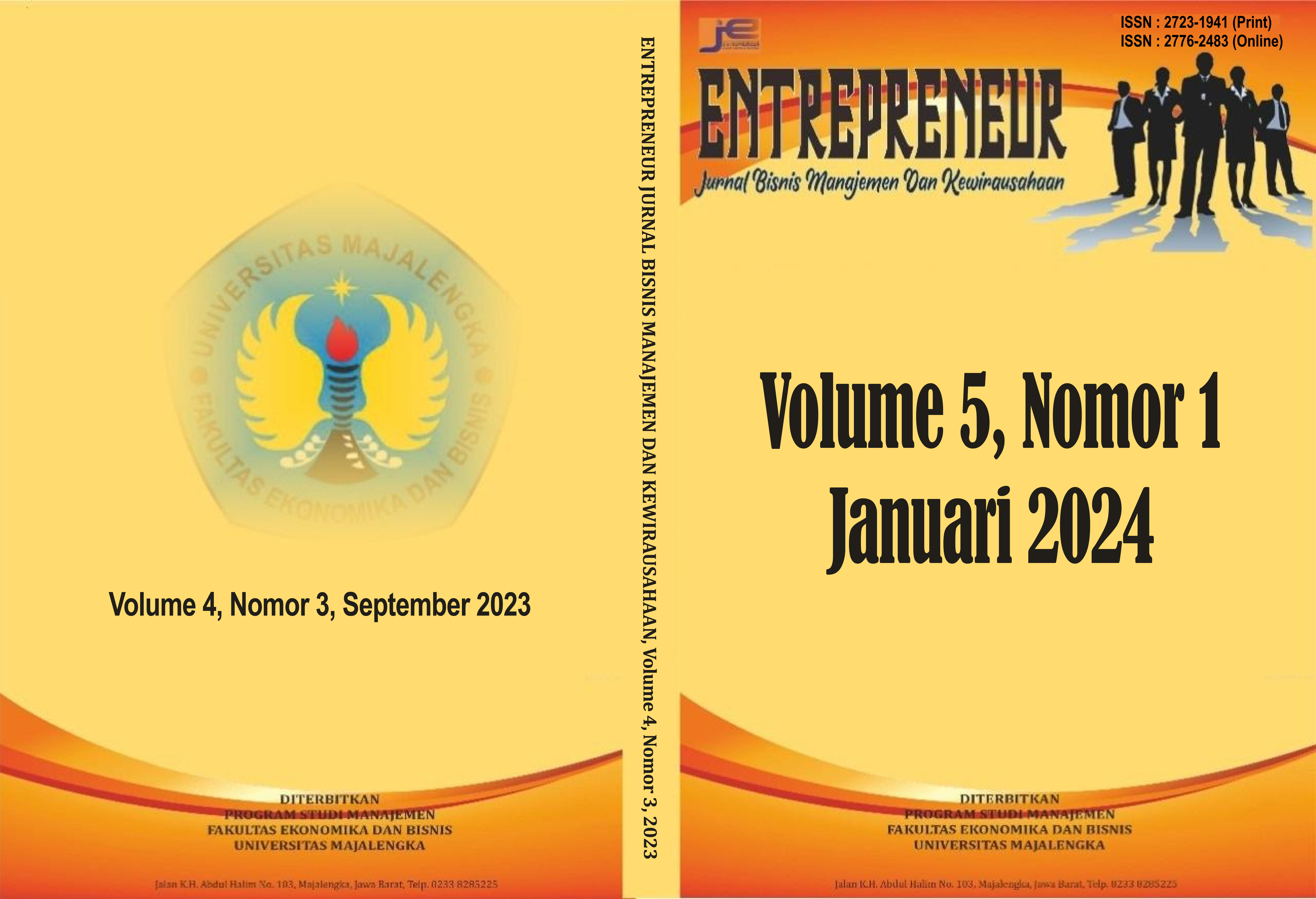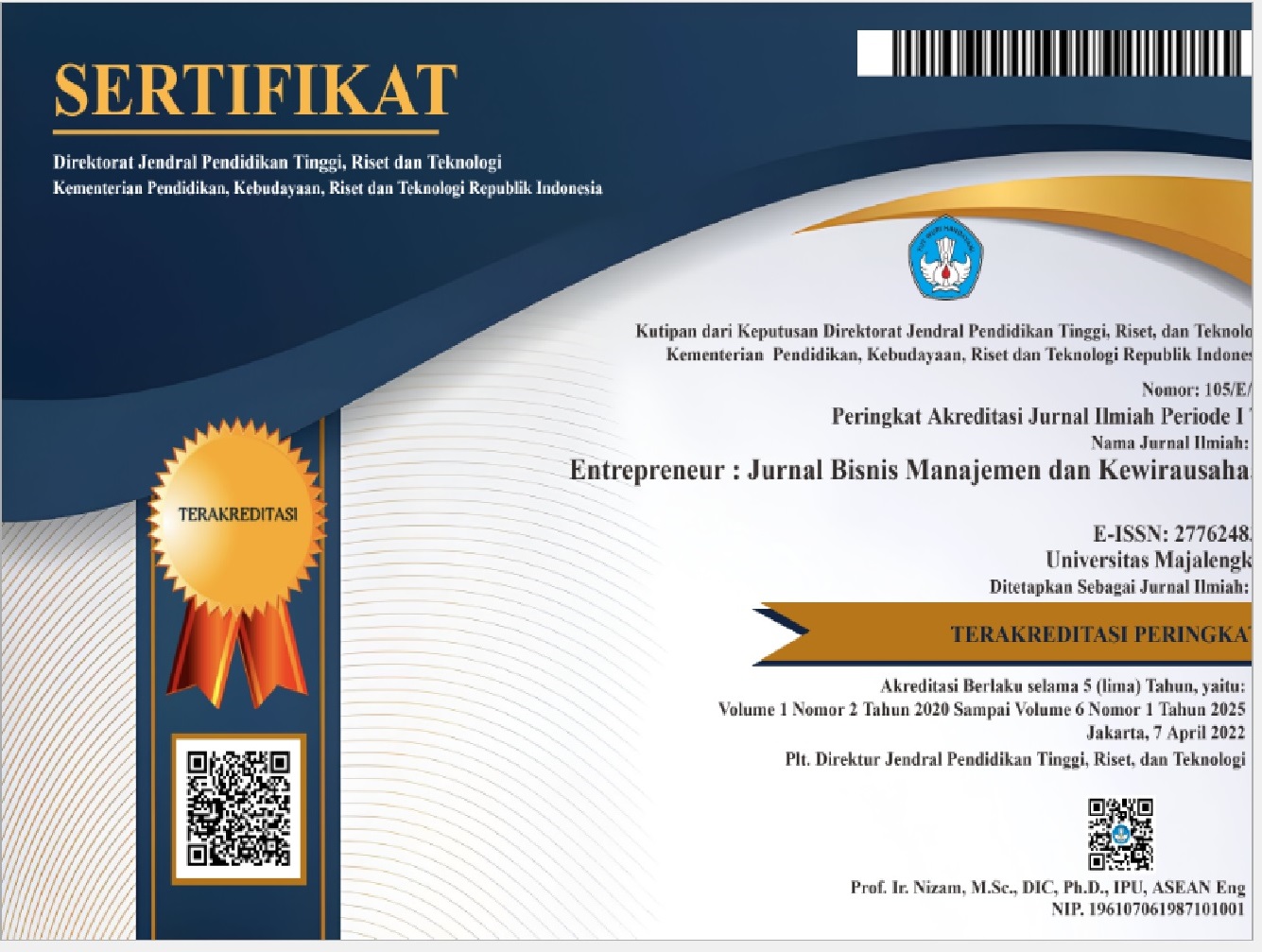Sistem Pengendalian Internal Kas Pada PT XYZ
DOI:
https://doi.org/10.31949/entrepreneur.v5i1.8115Abstract
The internal control system is important for companies to maintain company assets, accuracy and reliability of data, encourage efficiency, and encourage compliance with management policies. The cash control system also needs to be considered as an effort to monitor and supervise the company's cash activities. This research aims to evaluate and determine the implementation of the cash internal control system at PT XYZ. The type of research used is qualitative with a case study approach. The data sources used in this study are primary data and secondary data. The data collection techniques in this research used interviews and documentation. The determination of informants was carried out using the snowball sampling method and the data analysis used was the Miles and Huberman model, and to test the validity of the data using triangulation techniques. The results of the research obtained data based on 4 (four) elements of the internal control system show that the existing organizational structure at PT XYZ is appropriate, then in document authorization there are documents that do not have the signature of the finance director so that it is lacking in authorizing company documents, company activities have reconciliations that are carried out regularly, and in the recruitment process there are several criteria required. So it can be concluded that PT XYZ has been said to be quite good in internal cash control so that the objectives of implementing control are achieved quite well.
Keywords:
Cash outflow, cash receipts, internal control systemDownloads
References
Butar, R. B., & Zulkifli, Z. (2021). Analisis Sistem Pengendalian Intern Kas. JURNAL MANAJEMEN, ORGANISASI DAN BISNIS, 1(1), 36–42.
Fizriah, L., & Wirananda, H. A. (2022). Analisis Peranan Pengendalian Internal Atas Penjualan, Piutang Dan Penerimaan Kas Pada PT. Alfa Scorpii. Journal Economy And Currency Study (JECS), 4(1), 40–48.
Hery. (2015). Pengantar Akuntansi. PT Grasindo.
Husna, G. A., Hidayati, K., & Rahman, A. (2021). Analisis Sistem Pengendalian Intern Penerimaan dan Pengeluaran Kas pada PR. Sumber Barokah Sidoarjo. UBHARA Accounting Journal, 1(1), 179–185.
Madhani, I. D., & Nurlaila, N. (2022). Analisis Sistem Akuntansi Atas Penerimaan Kas Pada Pud. Pasar Kota Medan. Sibatik Journal: Jurnal Ilmiah Bidang Sosial, Ekonomi, Budaya, Teknologi, dan Pendidikan, 1(5), 627–634.
Masruri, M. A., & Handayani, A. (2023). ANALISIS PENDAPATAN PG. XYZ DI JAWA TIMUR. Digital Bisnis: Jurnal Publikasi Ilmu Manajemen dan E-Commerce, 2(1), 1–10.
Mulyadi. (2018). Sistem Akuntansi. Salemba Empat.
Prastyaningtyas, E. W. (2019). Sistem Akuntansi. Azizah Publishing.
Sakti, E. M. S., & Nursina, N. (2021). Pengembangan Fitur Invoice Pada Aplikasi Jasa Titip Berbasis Android. Jurnal Ilmiah Teknik Informatika (TEKINFO), 22(2), 35–39.
Santoso, R. A., & Handayani, A. (2022). Manajemen Keuangan: Keputusan Keuangan Jangka Panjang. UMG Press.
Selay, A., Andigha, G. D., Alfarizi, A., Wahyudi, M. I. B., Falah, M. N., Encep, M., & Khaira, M. (2023). Sistem Informasi Penjualan. KARIMAH TAUHID, 2(1), 232–237.
Sugiyono. (2020). Metode Penelitian Kualitatif. Penerbit Alfabeta.
Suhayati, E. (2021). Auditing. Rekayasa Sains.
Sujarweni, V. W. (2022). Sistem Akuntansi. Pustaka Baru Press.
Wati, D. (2023). Analisis Pengendalian Intern Pada Efektifitas Pengelolahan Kas PT. Abadi Sakti Mitra Mandiri Lampung. Jurnal EMT KITA, 7(4), 1062–1073.
Zandra, R. A. P., & Sholihah, Z. (2018). Efektivitas Pengendalian Internal Atas Transaksi Kas. Jurnal Kajian Akuntansi, 2(1), 54–66.

Published
How to Cite
Issue
Section
License
Copyright (c) 2024 Alwiyatun Nisa', Anita Handayani

This work is licensed under a Creative Commons Attribution-ShareAlike 4.0 International License.
COPYRIGHT NOTICE
An author who publishes in the Entrepreneur: Jurnal Bisnis Manajemen dan Kewirausahaan agrees to the following terms:
1. Author retains the copyright and grants the journal the right of first publication of the work simultaneously licensed under the Creative Commons Attribution-ShareAlike 4.0 License that allows others to share the work with an acknowledgment of the work's authorship and initial publication in this journal
2. The author is able to enter into separate, additional contractual arrangements for the non-exclusive distribution of the journal's published version of the work (e.g., post it to an institutional repository or publish it in a book) with the acknowledgment of its initial publication in this journal.
3. The author is permitted and encouraged to post his/her work online (e.g., in institutional repositories or on their website) prior to and during the submission process, as it can lead to productive exchanges, as well as earlier and greater citation of the published work







